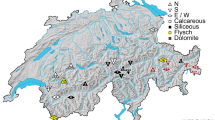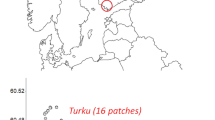Abstract
Based on the vague importance of shrub cover, an attempt was made to create a theoretical concept framework known as an ‘arthropod-island’ analytical model. These models were based on the multi-bond correlation between shrubs, soil properties, and above- and below-ground biotic communities. By utilizing published datasets on (i.e., above- and below-ground) arthropod communities related to shrub species and age, the proposed models for an ‘arthropod island’ were applied in order to determine their fitness for xeric ecosystems. It was found that the ‘arthropod-island’ concept could be the result of statistical differences in ecologically adaptive (i.e., preferable) redistribution of arthropods among the microhabitats beneath the shrub canopy and in the open spaces. Taxon density, relative to the richness and Shannon indices, was found to be more sensitive to the selected models. The relative interaction intensity index [RII = (A − B)/(A + B), A = shrub canopy value, B = intershrub value] was found to be more suitable for the ‘arthropod island’ at the community level. The relative neighbor effect [RNE = (B − A)/max(A, B)] and RII were found to be suitable at the population level, while the fitted model heavily depended on the variety of arthropod taxon. It was suggested that there were consistent ‘arthropod island’–shrub relationships between shrub species and between shrub ages in terms of arthropod density at the community level. The arthropod taxon was found to indicate an inconsistent ‘arthropod island’–shrub relationship between shrub species that differed from shrub ages at the population level.

Similar content being viewed by others
References
Aguiar MR, Sala OE (1999) Patch structure, dynamics and implications for the functioning of arid ecosystems. Trends Ecol Evol 14:273–277
Allington GRH, Valone TJ (2014) Islands of fertility: a byproduct of grazing? Ecosystems 17:127–141
Armas C, Ordiales R, Pugnaire FI (2004) Measuring plant interactions: a new comparative index. Ecology 85:2682–2686
Canepuccia AD, Cicchino A, Escalante A, Novaro A, Isacch JP (2009) Differential responses of marsh arthropods to rainfall-induced habitat loss. Zool Stud 48:174–183
Chen LD, Fu BJ, Zhao WW (2008) Source-sink landscape theory and its ecological significance. Front Biol China 3:131–136
Coleman DC, Crossley DAJ, Hendrix PF (2004) Fundamentals of soil ecology, 2nd edn. Elsevier, San Diego
Crist TO, Guertin DS, Wiens JA, Milne BT (1992) Animal movements in heterogeneous landscapes: an experiment with Eleodes beetles in shortgrass prairie. Funct Ecol 6:536–544
Doblas-Miranda E, Sánchez-Pinero F, González-Megías A (2009) Different microhabitats affect soil macroinvertebrate assemblages in a Mediterranean arid ecosystem. Appl Soil Ecol 41:329–335
Garner W, Steinberger Y (1989) A proposed mechanism for the formation of ‘Fertile Island’ in the desert ecosystem. J Arid Environ 16:257–262
Groner E, Ayal Y (2001) The interaction between bird predation and plant cover in determining habitat occupancy of darkling beetles. Oikos 93:22–31
Han P, Lavoir AV, Le Bot J, Amiens-Desneux E, Desneux N (2014) Nitrogen and water availability to tomato plants triggers bottom-up effects on the leafminer Tuta absoluta. Sci Rep 4:4455
Hedges LV, Gurevitch J, Curtis PS (1999) The meta-analysis of response ratios in experimental ecology. Ecology 80:1150–1156
Holmquist JG, Schmidt-Gengenbach J, Haultain SA (2013) Effects of a long-term disturbance on arthropods and vegetation in subalpine wetlands: manifestations of pack stock grazing in early versus mid-season. PLoS ONE 8:e54109
Li FR, Liu JL, Liu CA, Liu QJ, Niu RX (2013) Shrubs and species identity effects on the distribution and diversity of ground-dwelling arthropods in a Gobi desert. J Insect Conservation 17:319–331
Lindsey PA, Skinner JD (2001) Ant composition and activity patterns as determined by pitfall trapping and other methods in three habitats in the semi-arid Karoo. J Arid Environ 48:551–568
Liu RT (2015) Ecology of soil fauna in a desertified system. Science Press, Beijing
Liu RT, Zhao HL, Zhao XY (2009) Effect of vegetation restoration on ant nest-building activities following mobile dune stabilization in the Horqin Sandy Land, Northern China. Land Degrad Dev 20:562–571
Liu RT, Zhao HL, Zhao XY, Drake S (2011) Facilitative effects of shrubs in shifting sand on soil macro-faunal community in Horgin Sand Land of Inner Mongolia, Northern China. Eur J Soil Biol 47:316–321
Liu JL, Li FR, Liu CA, Liu QJ (2012) Influences of shrub vegetation on distribution and diversity of a ground beetle community in a Gobi desert ecosystem. Biodivers Conserv 21:2601–2619
Liu RT, Zhu F, Song NP, Yang XG, Chai YQ (2013) Seasonal distribution and diversity of ground arthropods in microhabitats following a shrub plantation age sequence in desertified steppe. PLoS ONE 8:e77962
Liu JL, Li FR, Sun TS, Ma LF, Liu LL, Yang K (2016) Interactive effects of vegetation and soil determine the composition and diversity of carabid and tenebrionid functional groups in an arid ecosystem. J Arid Environ 128:80–90
Lobry de Bruyn LA (1997) The status of soil macrofauna as indicators of soil health to monitor the sustainability of Australian agricultural soils. Ecol Econ 23:167–178
Markham JH, Chanway CP (1996) Measuring plant neighbour effects. Funct Ecol 10:548–549
McIntyre NE, Wiens JA (1999) How does habitat patch size affect animal movement? An experiment with darkling beetles. Ecology 80:2261–2270
Oksanen L, Sammul M, Mägi M (2006) On the indices of plant–plant competition and their pitfalls. Oikos 112:149–155
Paine RT (1992) Food-web analysis through field measurement of per-capita interaction strength. Nature 355:73–75
Parmenter RR, Parmenter CA, Cheney CD (1989) Factors influencing microhabitat partitioning in arid-land darkling beetles (Tenebrionidae): temperature and water conservation. J Arid Environ 17:57–67
Polis GA (1999) Why are parts of the world green? Multiple factors control productivity and the distribution of biomass. Oikos 86:3–15
Price PW (1997) Insect ecology: Behavior, populations and communities. Wiley, New York
Reynolds HL (1999) Plant interactions: Competition. In: Pugnaire FI, Valladares F (eds) Handbook of functional plant ecology. Marcel Dekker, New York, pp 649–676
Ridolfi L, Laio F, D’Odorico P (2008) Fertility island formation and evolution in dryland ecosystems. Ecol Society 13:5
Sanchez BC, Parmenter RR (2002) Patterns of shrub-dwelling arthropod diversity across a desert shrubland–grassland ecotone: a test of island biogeographic theory. J Arid Environ 50:247–265
Schlesinger WH, Reynolds JF, Cunningham GL, Huenneke LF, Jarrell WM, Virginia RA, Whitford WG (1990) Biological feedbacks in global desertification. Science 247:1043–1048
Schoonhoven LM, van Loon JJA, Dicke M (2005) Insect-plant biology. Oxford University Press, Oxford
Schowalter TD (2011) Insect ecology: An ecosystem approach. Academic Press, San Diego
Seeber J, Langel R, Meyer E, Traugott M (2009) Dwarf shrub litter as a food source for macro-decomposers in alpine pastureland. Appl Soil Ecol 41:178–184
Shachak M, Gosz JR, Pickett STA, Perevolotsky A (2005) Biodiversity in drylands: Toward a unified framework. Oxford University Press, New York
Siemann E (1998) Experimental tests of effects of plant productivity and diversity on grassland arthropod diversity. Ecology 79:2057–2070
Stapp P (1997) Microhabitat use and community structure of darkling beetles (Coleoptera: Tenebrionidae) in shortgrass prairie: effects of season, shrub cover and soil type. Am Midl Nat 137:298–311
Su YZ, Zhao HL (2003) Soil properties and plant species in an age sequence of Caragana microphylla plantations in the Horqin Sandy Land, north China. Ecol Eng 20:223–235
Tielbörger K, Kadmon R (1995) Effect of shrubs on emergence, survival and fecundity of four coexisting annual species in a sandy desert ecosystem. Ecoscience 2:141–147
Tielbörger K, Kadmon R (1997) Relationships between shrubs and annual communities in a sandy desert ecosystem: a three-year study. Plant Ecol 130:191–201
Tielbörger K, Kadmon R (2000) Temporal environmental variation tips the balance between facilitation and interference in desert plants. Ecology 81:1544–1553
Weigelt A, Jolliffe P (2003) Indices of plant competition. J Ecol 91:707–720
Wilson SD, Keddy PA (1986) Measuring diffuse competition along an environmental gradient: results from a shoreline plant community. Am Nat 127:862–869
Wilson SD, Tilman D (1993) Plant competition in relation to disturbance, fertility and resource availability. Ecology 74:61–71
Yin WY (2000) Pictorial keys to soil faunas of China. Science Press, Beijing (in Chinese)
Zhao HL, Liu RT (2013) The “bug island” effect of shrubs and its formation mechanism in Horqin Sand Land, Inner Mongolia. Catena 105:69–74
Ziesche TM, Roth M (2008) Influence of environmental parameters on small-scale distribution of soil-dwelling spiders in forests: what makes the difference, tree species or microhabitat? Forest Ecol Manag 255:738–752
Acknowledgments
We thank the anonymous reviewers for their valuable comments. Special thanks to Ms. Sharon Victor for her valuable comments. Thank you to the Key Laboratory for Restoration and Reconstruction of Degraded Ecosystem in Northwestern China of the Ministry of Education, Ningxia University for expert assistance. This project was supported by the Fok Ying Tung Education Foundation (Grant No. 151103), Ningxia Higher Education Foundation (Grant No. NGY2015053), Ningxia Natural Science Foundation (Grant No. NZ15025), and CSC/BU Joint Scholarships and Kort Postdoc Program.
Author information
Authors and Affiliations
Corresponding author
Additional information
Handling Editor: Heikki Hokkanen.
Rights and permissions
About this article
Cite this article
Liu, R., Pen-Mouratov, S. & Steinberger, Y. Shrub cover expressed as an ‘arthropod island’ in xeric environments. Arthropod-Plant Interactions 10, 393–402 (2016). https://doi.org/10.1007/s11829-016-9450-z
Received:
Accepted:
Published:
Issue Date:
DOI: https://doi.org/10.1007/s11829-016-9450-z




